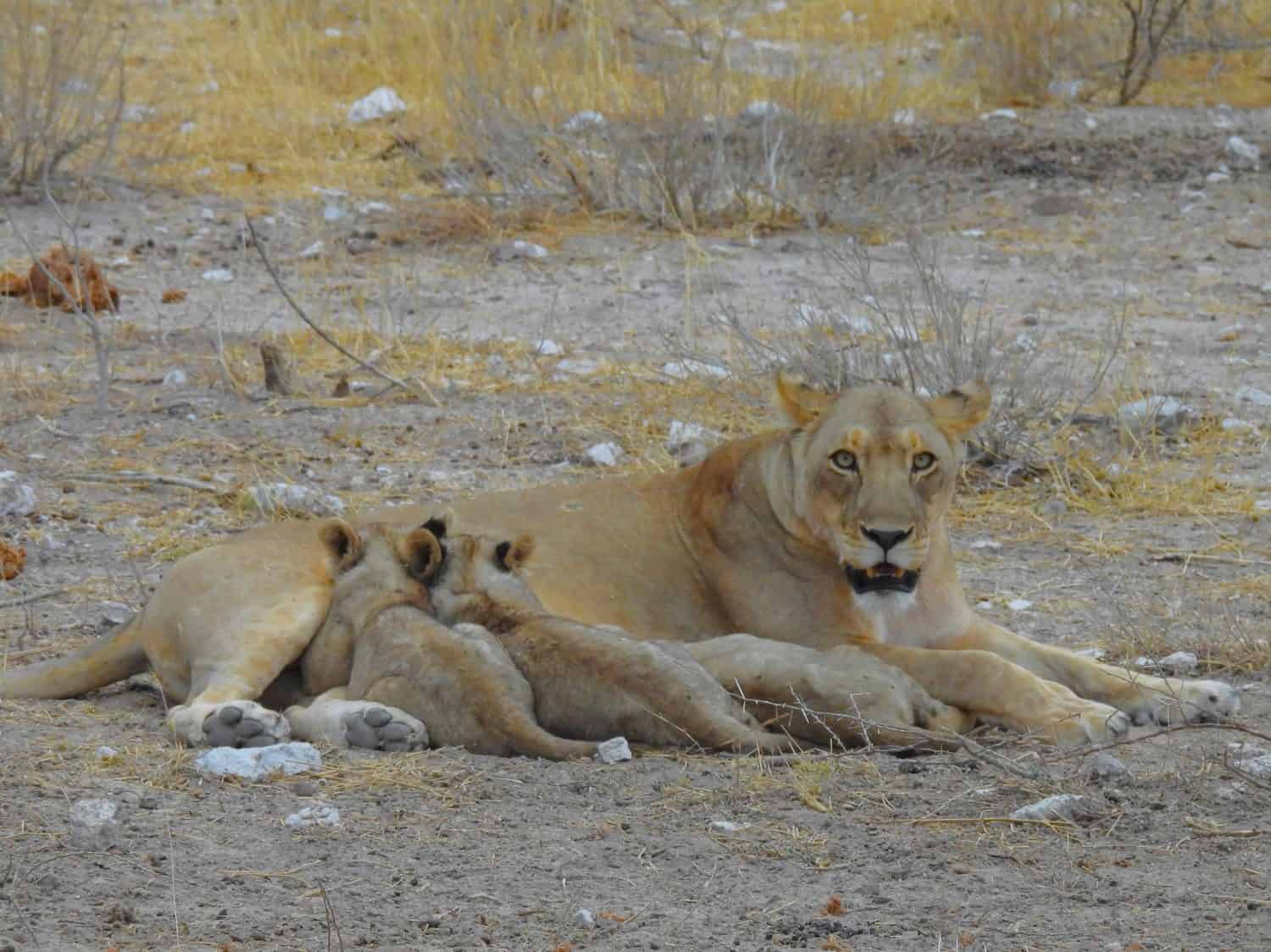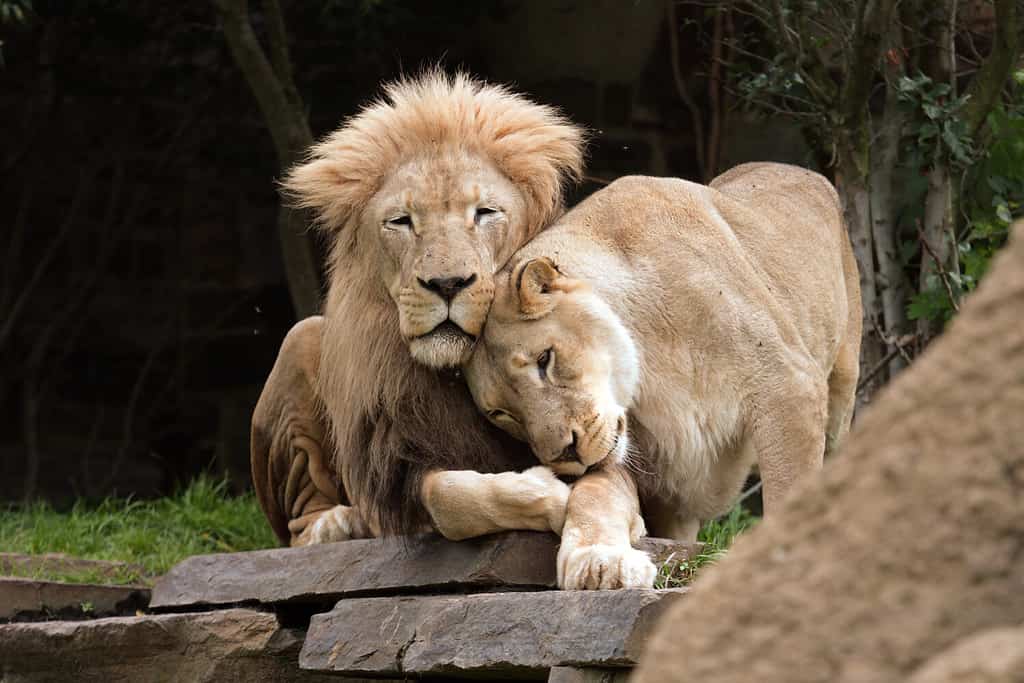Lions (Panthera leo) are highly social felines who live in groups called prides. Genetically related females form the main social unit, and males are only associated with the pride for a few years before moving on. Males also form loose social arrangements called coalitions, which makes it easier for them to both hunt successfully and defend the pride from other males. The females live co-operatively and hunt together. They also raise their cubs together. All of this takes a lot of communication! So, let’s discover how lions communicate with each other and then focus on the 7 sounds lions make and what they mean.
How Do Lions Communicate?
Lions have an extensive range of communication methods. They use tactile communication, including head rubbing, social licking, and leaning against each other. Lions also have facial expressions and body language to help with visual communication. Scent marking is also important to mark territories and identify individuals. Lions produce chemical messages in their saliva, urine, feces, and scent glands.
Do Lions Communicate With Sounds?
In addition to all the above methods of communication, lions also use sound. As well as varying the type of sound, they can also alter the volume, intensity, and frequency.
Here is a quick summary of the sounds that they can make and what the experts think they mean.
1. The Roar
The lion’s roar is one of the most iconic wildlife sounds, but it is actually a complex mix of vocalizations. Roars start with a few subdued calls with spaces between them. Then, the calls accelerate and increase in volume. At its peak, there are up to 18 thunderous sounds (that can be heard up to five miles away) before ending with a series of grunts. Cubs cannot roar; this is a skill that develops in adulthood. Lions may roar spontaneously but also respond to other lion’s roars. The sound probably serves a number of functions, including advertising the position of the pride, declaring ownership of a territory, and intimidating a rival. When lions roar together, it strengthens social bonds. Lions can use a combination of roars and grunts, as you can hear in the above clip.
2. The Grunt
Lionesses use a soft grunting sound to call her cubs towards her. It basically means “come back to mummy”. Lionesses are very protective of their cubs and like to know where they are at all times. This is a friendly sound that lions also use to locate pride members that are not within their sight. It is a low and repetitive guttural sound that you can clearly hear at the start of this clip.
3. The Growl
Lions sometimes use a growling sound that acts as a warning. It is a threat not to approach them or their pride. Sometimes a warning growl sounds like a cough – this is essentially a short explosive growl! You can hear the coughing sound at the start of this clip. Lions also actually cough – but this is often because they are expelling something from their throat!
4. The Snarl and Hiss
Lions can snarl and hiss in a way that is very similar to that of domestic cats. As you can see in the above clip, their mouth is open, and they are drawing back their lips to show their teeth. They often use this if they do not like what is approaching them – especially if it is another lion.
5. The Hum

Lionesses hum when they are suckling their cubs.
©Brian Stuart Nel/Shutterstock.com
Lions cannot purr, but they still have a sound that shows contentment. Smaller cats such as domestic cats and bobcats, can purr because they have a tightly connected linkage of delicate bones running from the back of their tongue to the base of their skull. Purring is essentially a vibration of the larynx, which makes the hyoid bones resonate. Some cat species can make this sound when breathing in and out, but lions cannot. They have tough cartilage running up the hyoid bones which enables them to roar but prevents purring! Nevertheless, lionesses can still make a humming sound when they are contentedly suckling their cubs. It means exactly the same as a purr.
6. The Puff

Lions puff as a friendly greeting, often accompanied by head rubbing.
©Wicker Imaging/Shutterstock.com
Lions can emit a puffing sound through closed lips, and they do this repeatedly when they approach other lions in a friendly way. It shows that they are not being threatened and signals non-aggression. It may used by pride members to greet each other.
7. The Meow
Young cubs can make a higher-pitched meow sound. It is typically used as a distress call to try and attract the mom lion’s attention. It helps the lioness to keep track of her cubs at close range. If the meows become more intense, it indicates that the cub is in distress. Lion cubs are also able to hiss and spit from shortly after birth and can make humming noises. If the whole pride is roaring, the cubs will join in with their high-pitched meows.
Summary of Lion Sounds
| Sound | Purpose |
|---|---|
| The Roar | Long-distance declaration of position. |
| The Grunt | Used to locate pride members, especially cubs. |
| The Growl | A warning. |
| The Snarl and Hiss | Defensive sound indicating displeasure. |
| The Hum | Conveys contentment – similar to purring. |
| The Puff | A greeting between friends. |
| The Meow | Used by cubs to get attention. |
The photo featured at the top of this post is © Redmich/Shutterstock.com
Thank you for reading! Have some feedback for us? Contact the AZ Animals editorial team.






